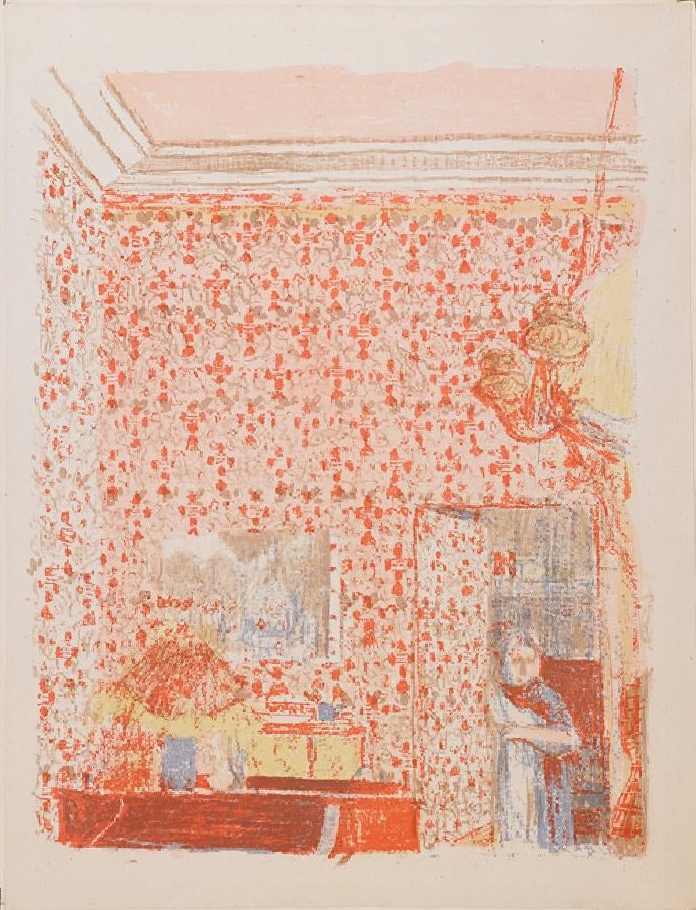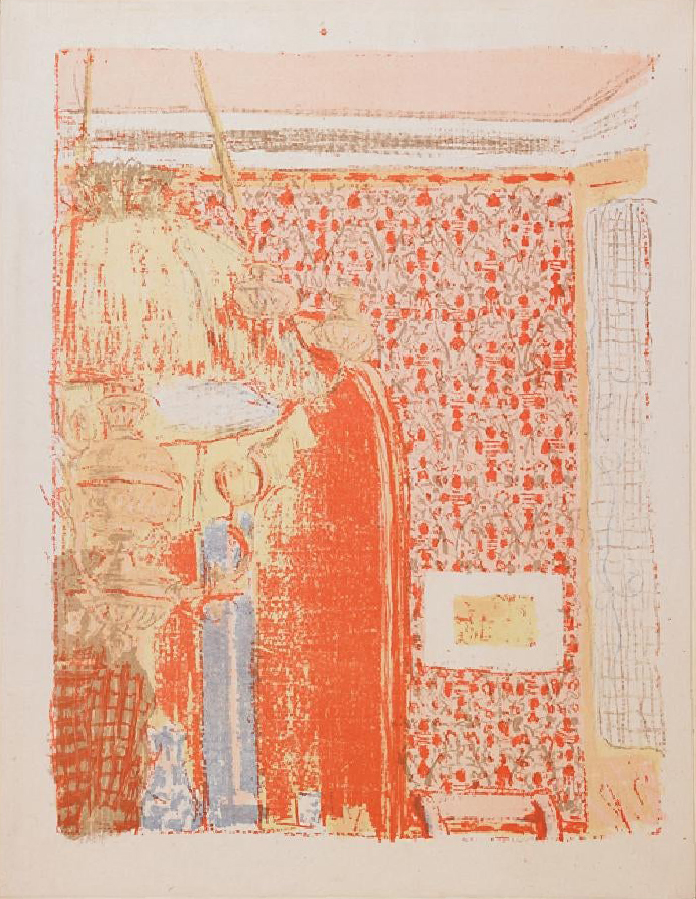
|
|
|
Intérieur aux
Tentures Roses I - II
Roger-Marx 36, 37
two five-colour
lithographs,
1899, the 4th state ( of 4) and the 2nd state (of 2), respectively, on
fine white chine volant
paper, expertly backed on wove, fine trial proof impressions, with good
margins and bright colours, quite as published in Ambroise Vollard's album Paysages et Intérieurs (an edition of 100), a few slight scuffs at
the top sheet edges, and faint light staining from a old mount on the second proof, otherwise in relatively good condition
P. 340 x 270 mm.
S. 393x305 and 393x307 mm.

|
These two prints,
as part of Vollard's commercially unsuccessful album, are now
considered simply to represent "the synthesis and the conclusion of Vuillard's
graphic art".*
Vuillard had not experimented
with colour lithography as regularly as Bonnard, but he urgently
directed its practice according to his deeply personal artistic
vision. As he wrote in his notebooks** (Carnets Intimes):
Hier
soir Kerr et moi accoudés à la fenêtre de la salle à manger regardons
dans la nuit le mur rougeâtre éclairé par la lune encadré par les
arbres noirs. Le ciel par courtes échancrures du décor, bleu clair avec
étoiles scintillantes.Causerie. La nature, la transcription, l'objet.
[...] Voyant ma figure dans une glace, ma barbe dorée par la lumière la
peau, les yeux mous, la prunelle et son accent carré le front un peu
gras, les cheveux rares et mal plantés, mal portant, d'une couleur gris
argentée, les sourcils en désordre et ombrant les yeux. L'air peinard
et attentif. N'est-ce pas là une transcription des images de ma pensée
en formes communes et ces notations plus générales que des lignes ou
des taches, ne peuvent-elles me rappeler, m'évoquer les images-mères.
En peinture, n'est-ce pas de même l'évocation de ces images intérieures
par des moyens très généraux aussi, couleurs et formes. L'art consiste
à introduire un ordre dans ces moyens, suggestif de ces images.
[Last night Kerr and I leaned out of the dining room window and looked
into the night at the red wall lit by the moon, framed by the black
trees. The sky, by short breaks in the decor, light blue with
glittering stars. Light banter. Nature, transcription, the
object. [...] Seeing my face in the mirror, my beard gilded by the
light, the skin, the soft eyes, the pupil with its sharp accent, the
forehead a bit greasy, the hair spare and badly planted, badly groomed,
a silver-gray color, eyebrows bushing and shading the eyes. The air
stodgy and attentive. Is this not a transcription of the images of my
thought into common forms, and these notations more general than lines
or spots, how can they not remind me, evoke these mother-images.
In painting, is it not the same evocation of these inner images by very
general means too, colors and shapes. Art consists in introducing an
order into these means, suggestive of these images.]
This is, in our mind, the most cogent description possible of rendering the artist's apperceptive vision...
According to Roger-Marx,
Vuillard especially worked the colours on these lithographs: brick red,
pale pink, light yellow, slate blue, mouse grey for the first print;
for the second, Roger-Marx more simply described them as yellow, pink, red, blue, grey,
though he notes too that Vuillard worked each stone in detail, altering the green
highlights, or replacing the green with a greyish brown...
As regards the identifcation
of these two impressions as trial proofs, even though they are
relatively conformant with the published impressions,*** there are
clear discrepancies. In the present case, we need cite the
cleaning of the lower edge of the stones for the first lithograph,
where there is a reddish blue extrusion below the apron of the table
that is not apparent in the documented edition, and secondly, the
visible registration mark in the upper margin of the second lithograph
that attest this.
* "la synthèse et la
conclusion de l'art graphique de Vuillard", François Fossier, La Nebuleuse Nabis, RMN 1993, page 140
** François Alexandre, Béatrie Didier, Carnets
Intimes (1888-1905 et 1er janvier 1914-11 novembre 1918) : édition
critique avec présentation, notes, annexes et bibliographie, 1998
*** It is also quite probable that Vollard did not undertake the full print run in extenso, despite the announced edition size of 100:
Cf. the following online documents :
https://gallica.bnf.fr/ark:/12148/btv1b10520541n.item
https://gallica.bnf.fr/ark:/12148/btv1b10520539t.item
The detailed description of Hélène Bonafous-Murat:
http://www.ader-paris.fr/html/fiche.jsp?id=5461605&np=1&lng=fr&npp=50&ordre=2&aff=5&r=



